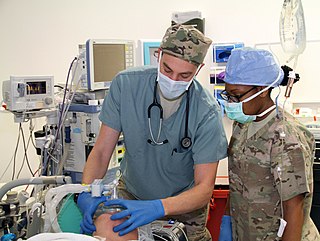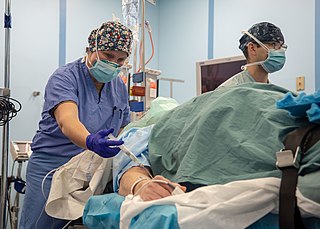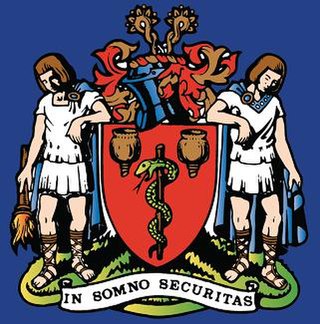
General anaesthesia (UK) or general anesthesia (US) is a method of medically inducing loss of consciousness that renders a patient unarousable even with painful stimuli. This effect is achieved by administering either intravenous or inhalational general anaesthetic medications, which often act in combination with an analgesic and neuromuscular blocking agent. Spontaneous ventilation is often inadequate during the procedure and intervention is often necessary to protect the airway. General anaesthesia is generally performed in an operating theater to allow surgical procedures that would otherwise be intolerably painful for a patient, or in an intensive care unit or emergency department to facilitate endotracheal intubation and mechanical ventilation in critically ill patients. Depending on the procedure, general anaesthesia may be optional or required. Regardless of whether a patient may prefer to be unconscious or not, certain pain stimuli could result in involuntary responses from the patient that may make an operation extremely difficult. Thus, for many procedures, general anaesthesia is required from a practical perspective.

Anesthesiology, anaesthesiology or anaesthesia is the medical specialty concerned with the total perioperative care of patients before, during and after surgery. It encompasses anesthesia, intensive care medicine, critical emergency medicine, and pain medicine. A physician specialized in anesthesiology is called an anesthesiologist, anaesthesiologist, or anaesthetist, depending on the country. In some countries, the terms are synonymous, while in other countries, they refer to different positions and anesthetist is only used for non-physicians, such as nurse anesthetists.
The Australian and New Zealand College of Anaesthetists (ANZCA) is responsible for examining and qualifying anaesthetists in Australia and New Zealand. The College maintains standards of practice in anaesthesia.

A nurse anesthetist is an advanced practice nurse who administers anesthesia for surgery or other medical procedures. Nurse anesthetists (NA's) administer or participate in administration of anesthesia services in 107 countries, working with or without anesthesiologists. Because of different historical backgrounds, anesthetist responsibilities and roles vary widely between countries. Depending on the locality, their role may be limited to intraoperative care during anesthesia itself or may also extend before and after. The International Federation of Nurse Anesthetists was established in 1989 as a forum for developing standards of education, practice, and a code of ethics.

The Association of Anaesthetists, in full the Association of Anaesthetists of Great Britain and Ireland (AAGBI), is a professional association for anaesthetists in the United Kingdom and Ireland.
The Primary FRCA is a postgraduate examination in anaesthesia, more fully called the Primary Examination of the Diploma of Fellowship of the British Royal College of Anaesthetists (RCoA).
The American Society of Anesthesiologists (ASA) is an educational, research and scientific association of physicians organized to raise the standards of the medical practice of anesthesiology and to improve patient care.
In the United Kingdom, operating department practitioners (ODPs) are allied healthcare professionals who are involved in the planning and delivery of perioperative care. As the name suggests, they are primarily employed in surgical operating departments, but they may also work directly within a variety of acute clinical settings, including pre-hospital emergency care, emergency departments, intensive care units (ICUs), endoscopy suites, interventional radiology, cardiac catheter suites, obstetric theatres and reproductive medicine.
The Final FRCA is a postgraduate examination in anaesthesia, more fully called the Final Examination of the Diploma of Fellowship of the Royal College of Anaesthetists.
Harold Randall Griffith was a Canadian anesthesiologist and a leader in the fields of anesthesiology.
Geoffrey Kaye (1903–1986) was an Australian anaesthetist.
The following outline is provided as an overview of and topical guide to anesthesia:
Teresa (Tess) Rita O'Rourke Cramond AO, OBE (1926-2015) was an Australian doctor and the director of the Multidisciplinary Pain Centre at the Royal Brisbane Hospital. Her career spanning fifty years, was dedicated to improving the use of anaesthesia, resuscitation and pain medicine, with specific reference to the relief of cancer pain and palliative care.
Judith Hulf is a British anaesthetist. She was the president of the Royal College of Anaesthetists from 2006 to 2009.

Peter John Firth Baskett (1934–2008) was a Northern Irish physician, specializing in anaesthesia. He was responsible for the introduction of paramedics into the United Kingdom, created specialist ambulances for delivering on-scene pain relief to patients, and was the first chairman of the European Resuscitation Council.
Mary Burnell was an anaesthetist who worked with both adults and children. She is known for her work advocating for pediatric anaesthesia specialists.
Eva Ruth Seelye was a New Zealand anaesthetist in the cardiothoracic surgical unit at Green Lane Hospital, Auckland from 1962 to 1985.

Anaesthetists United is a medico-political advocacy group in the United Kingdom co-founded by Ramey Assaf and Richard Marks in June 2023 to campaign against the proposed expansion of Anaesthesia Associates (AAs), as proposed by the NHS Long Term Workforce Plan. The group, composed of around 20 anaesthetists, undertook work to draft motions and submitted a requisition to the Royal College of Anaesthetists (RCoA) for an Extraordinary General Meeting (EGM) which took place on 17 October 2023. It successfully campaigned on issues relating to the training of anaesthetists.
Amanda Baric is an Australian anaesthesiologist. She has been key to the Australian collaboration with Mongolia to develop training courses for anaesthesiologists for which work, she was awarded the Order of the Polar Star of Mongolia. This work has also extended to Myanmar.
Katherine Leslie is an Australian anaesthetist, medical practitioner, and medical researcher. She is head of research in the Department of Anaesthesia and Pain Management at the Royal Melbourne Hospital (RMH). Leslie was the first anaesthetist to be honoured with a Doctor of Medical Science by the University of Melbourne in 2017.






